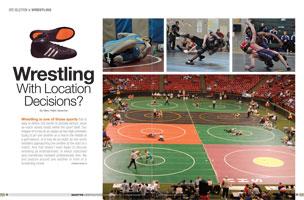
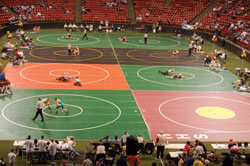 Wrestling is one of those sports that is easy to define, but harder to actually picture, since so much variety exists within the sport itself. Our images of it may be as classic as two high schoolers trying to pin one another on a mat in the middle of a gymnasium, or it may be as exotic as two sumo wrestlers approaching one another at the start of a match. And that doesn't even begin to discuss wrestling as entertainment, in which costumed (and sometimes masked) professionals dive, flip and posture around one another in front of a screaming crowd.
Wrestling is one of those sports that is easy to define, but harder to actually picture, since so much variety exists within the sport itself. Our images of it may be as classic as two high schoolers trying to pin one another on a mat in the middle of a gymnasium, or it may be as exotic as two sumo wrestlers approaching one another at the start of a match. And that doesn't even begin to discuss wrestling as entertainment, in which costumed (and sometimes masked) professionals dive, flip and posture around one another in front of a screaming crowd.
Wrestling itself is an ancient sport that is actually classified as a martial art, in which athletes use grappling techniques to try to gain and maintain a superior position. It is mentioned as far back in literature as Homer's Iliad,as well as in Greek mythology. Together with track and field events, it may have been one of the earliest sports contested in what were to become the Olympic Games.
As an event planner, you're less worried about wrestling's ancient history than you are about its immediate future, meaning the event you're putting together right now. And whether you're planning a meet, skills camp or championship, you're the one who wants to come out on top. But where do you start? On the mat, in the ready position. Consider this your coaching on how to choose the right facility for a great event.
Who's In Charge?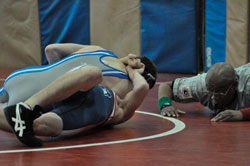 The governing body of the sport of wrestling is the International Federation of Associated Wrestling Styles (FILA). FILA recognizes various different styles of wrestling, including freestyle wrestling (two subsets of which are scholastic and collegiate wrestling), Greco-Roman wrestling, submission wrestling, combat grappling, beach wrestling and sambo. (Sumo wrestling is not governed by FILA but instead by the Japan Sumo Association). Information on the particulars of each style can be obtained through the governing bodies.
The governing body of the sport of wrestling is the International Federation of Associated Wrestling Styles (FILA). FILA recognizes various different styles of wrestling, including freestyle wrestling (two subsets of which are scholastic and collegiate wrestling), Greco-Roman wrestling, submission wrestling, combat grappling, beach wrestling and sambo. (Sumo wrestling is not governed by FILA but instead by the Japan Sumo Association). Information on the particulars of each style can be obtained through the governing bodies.
Within the United States, it is possible to find organizations dedicated to, and competitions for athletes in, all types of wrestling. However, because the freestyle version of the sport is so overwhelmingly popular at the high school level (where, together with middle school wrestling programs, it falls under the heading of scholastic wrestling) and college level (known as collegiate wrestling), it is likely that most event planners who are seeking venues for wrestling will be interested in these types of events.
According to the National Federation of State High School Associations (NFHS) sports participation summary, wrestling was the eighth most popular sport among boys during the 2008-2009 academic year, with 267,378 students participating. (Although girls may participate in wrestling programs, comparatively few do; the same NFHS summary showed just above 6,000 girls as participants). While the NCAA's sports participation study showed an overall drop in the number of wrestling programs offered, the sport remains popular, with the National Collegiate Athletic Association (NCAA) Wrestling Team Championship being held each year.
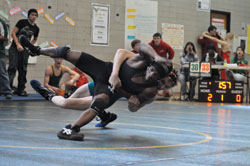 While many sports classify athletes by age (such as in Little League baseball) or by skill level (such as in tennis), wrestling classifies athletes by weight. Within collegiate wrestling, a total of 10 main weight classes are recognized by the NCAA. (Another organization, the National Collegiate Wrestling Association [NCWA], uses an additional weight class for male wrestlers at the top end of the weight classification, and also offers eight weight classes for women.) Scholastic wrestling is regulated by the NFHS and in most states, 14 weight classes are recognized.
While many sports classify athletes by age (such as in Little League baseball) or by skill level (such as in tennis), wrestling classifies athletes by weight. Within collegiate wrestling, a total of 10 main weight classes are recognized by the NCAA. (Another organization, the National Collegiate Wrestling Association [NCWA], uses an additional weight class for male wrestlers at the top end of the weight classification, and also offers eight weight classes for women.) Scholastic wrestling is regulated by the NFHS and in most states, 14 weight classes are recognized.
Facilities and Equipment
The wrestling season is generally from fall to spring (late October/early November to mid-March is the window most often associated with the sport). Both collegiate and scholastic wrestling are contested indoors, usually in a gymnasium, field house or other indoor multi-purpose area.
Thick rubber mats specifically designed and marked for wrestling are laid over the floor, which generally is coated wood, coated cement or an indoor multi-sport surface. The mat is made of thick rubber in order to ensure the safety of competitors. NCAA and NFHS have specifications regarding the dimensions and markings. (Note that markings and sizes of mats also differ for the various other types of wrestling recognized by FILA.)
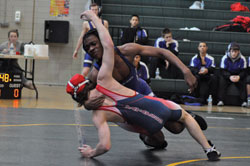 Any planner of a wrestling event should ascertain that the correct number of mats is available, and that those mats are in accordance with the sport's current rules. In addition, it is essential that mats be kept clean between matches and meets. In high school and college level sporting events in particular, much attention has been paid to the dangers of antibiotic-resistant infections (the so-called 'superbugs'), and, as a result, greater efforts are being made to keep facilities and equipment sanitized and safe.
Any planner of a wrestling event should ascertain that the correct number of mats is available, and that those mats are in accordance with the sport's current rules. In addition, it is essential that mats be kept clean between matches and meets. In high school and college level sporting events in particular, much attention has been paid to the dangers of antibiotic-resistant infections (the so-called 'superbugs'), and, as a result, greater efforts are being made to keep facilities and equipment sanitized and safe.
"Methicillin-resistant Staphylococcus aureus (MRSA), the staph bug, is an issue in all fitness facilities, but particularly when it comes to wrestling, because of the high amount of skin-to-floor contact inherent to wrestling," says Robert Cohen of Robert Cohen LLC in Albuquerque, New Mexico. "MRSA lives on surfaces, and enters the body through the skin, primarily through cuts or scratches. As a result, it is even more important that the floor is not a potential breeding ground for MRSA. Wrestling occurs on cushioned vinyl mats that sit on the floor. We recommend a vulcanized rubber floor covering under the mats, because vulcanized rubber is naturally and inherently antibacterial and antimicrobial. Besides MRSA, a rubber floor will prevent growth of ringworm and athlete's foot."
Officials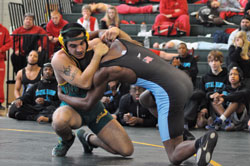 Depending on the number of wrestlers who will be present and competing, a large number of official personnel may be necessary. Many meets and tournaments involve multiple wrestling matches going on at the same time in fairly close proximity to one another. Each match will need a referee who can give the wrestlers his or her undivided attention. Scorers record the points of individual wrestlers and timekeepers are responsible for tracking the match time, any timeouts and so forth. Any of these personnel may have assistants. Event planners should ascertain the number of wrestlers competing, and plan accordingly for the support staff needed. A local athletic association should be able to help locate officials;however, remember that during a busy season, officials' time will need to be reserved well in advance.
Depending on the number of wrestlers who will be present and competing, a large number of official personnel may be necessary. Many meets and tournaments involve multiple wrestling matches going on at the same time in fairly close proximity to one another. Each match will need a referee who can give the wrestlers his or her undivided attention. Scorers record the points of individual wrestlers and timekeepers are responsible for tracking the match time, any timeouts and so forth. Any of these personnel may have assistants. Event planners should ascertain the number of wrestlers competing, and plan accordingly for the support staff needed. A local athletic association should be able to help locate officials;however, remember that during a busy season, officials' time will need to be reserved well in advance.
Wrestling Gear
While wrestling isn't as equipment-heavy a sport as football or baseball, athletes do come to competitions, camps and other events carrying specific items. Wrestlers on the scholastic and collegiate level are required to wear a singlet (a one-piece nylon or spandex garment), special wrestling shoes and protective headgear. They also have the option of wearing other equipment such as mouth guards, knee pads, etc. This means that wrestlers will need a place to store their equipment and/or their street clothes between matches.
The Facility Itself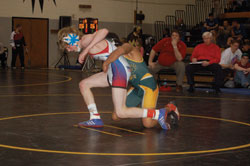 The indoor facility chosen for any competitive wrestling event should have the following:
The indoor facility chosen for any competitive wrestling event should have the following:
A flat, smooth, unblemished floor with enough square footage for multiple mats to be laid down, with sufficient space between mats to allow referees and other official personnel to walk around unimpeded and see the wrestlers from all angles while they are competing.
Storage space for mats that are not in use.
High ceilings and a good HVAC system to ensure athletes' safety and comfort.
Places for team members to sit while waiting for their next match; space for coaches and other team personnel as well.
Room for scoring tables,media and others.
Locker rooms, showers and/or changing areas (many players will arrive carrying their competition clothing and equipment and will require privacy to change).
Rest rooms and drinking fountains.
Spectator seating.
Lockers or other safe storage areas for athletes' property.
Public address system and scoreboards.
Camp and Clinic Equipment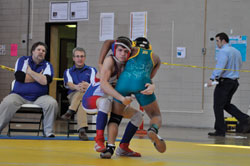 For those who are planning a wrestling camp or skills clinic, other amenities (in addition to many or all of the above) will be desirable. A weight room is appreciated by those who are in training, and wrestling-specific instruction and practice equipment such as throw dummies and a takedown machine can be used to demonstrate and encourage proper training form as well. A place to show instructional DVDs (with appropriate lighting and seating) may also be useful.
For those who are planning a wrestling camp or skills clinic, other amenities (in addition to many or all of the above) will be desirable. A weight room is appreciated by those who are in training, and wrestling-specific instruction and practice equipment such as throw dummies and a takedown machine can be used to demonstrate and encourage proper training form as well. A place to show instructional DVDs (with appropriate lighting and seating) may also be useful.
What Else?
Permitting: Make sure all necessary paperwork has been completed, including permitting for special activities that might be held in conjunction with your wrestling event.
Concessions: If high schools and colleges are competing, they may wish to set up booths to sell hot dogs, pennants, etc., in order to fund raise.
Parking: Make sure there is adequate parking for all those in attendance, including handicap-accessible parking.
Insurance: In any sporting event, insurance is critical. Speak with your legal counsel and your insurance advisor, as well as the facility management, to make sure all appropriate coverage is in place.
Emergency Facilities: Unfortunately, injuries and emergencies occur. Any venue should have a first-aid tent or office, and be accessible to emergency personnel.
What else?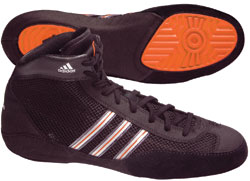 Accommodations: Are there hotels, motels and campgrounds available? Even the best-run sporting event will be complained about if accommodations are too far away.
Accommodations: Are there hotels, motels and campgrounds available? Even the best-run sporting event will be complained about if accommodations are too far away.
What's Fun? All sporting events should be accessible to attractions that players, spectators and others can take advantage of during downtime. Of interest to youth might be areas with restaurants, malls and indoor or outdoor recreation appropriate to the local weather. Older attendees might prefer historical sites, cultural attractions or nightlife.
This is your chance to pin down the details now in order to have a perfect wrestling event. Do the prep work, pick the right facility and you'll come out the victor.

